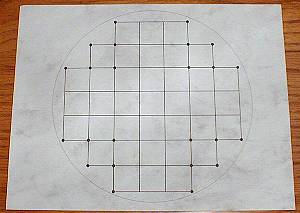
GRO: Battle For The Petri Dish
Interformic Games (Designer: Greg Turner)
Reviewed by Greenwood Gamers
May 28, 2000
With "GRO" Interformic has produced a simple, yet very strategic game for 2 players.
THE BITS
The Ziploc bag that "GRO" arrives in contains 32 tokens (16 each of red and blue), a 2-page rules booklet, the game board, and 2 sheets with illustrations on one side and example turns on the other. The rules are printed on standard weight paper while the game board and illustration/example sheets are printed on more substantial card stock, ensuring that they will better withstand wear.
THE GAME

The board is a circle with an inlaid grid (above). Your goal is to control 3 of the "corners" in the petri dish. You control a corner when you have at least one of your germs in the "corner" area and your opponent has no germs in the area. On the first turn each player places one of their germs directly onto the board. During each subsequent turn you may Move, Grow, or Divide an existing germ on the board, but you never directly place another germ on the board. You may have small (1 token), medium (2 tokens), or large (4 tokens) germs. On each of your turns you may do one of the following:
Move: You may move one of your germs to an adjacent point. To move a germ itís origination and destination points must have enough "Liberties". A liberty is an adjacent orthogonal (not diagonal) point. Small germs must have 1 liberty, medium germs 2 liberties, and large germs 3 liberties.
Grow: You may double the size of one of your small or medium germs (No growing larger germs, sorry). To grow a germ you must have enough tokens remaining and after the germ has grown it must have enough liberties for itís new size.
Divide: You may divide one of your medium or large germs. If a germ does not have enough liberties for its size, it may not divide. To divide a germ, take half of the germs tokens and move them to an adjacent point. The destination point must have enough liberties for the new germs size.
If a germ ever has 0 liberties it dies. When counting liberties to determine if a germ may move or divide, you may count any liberties you create by killing another germ. The illustration/example sheets are very helpful when learning the game, but will probably not be needed after the first couple games.
The rules are easy enough to learn, and by the third or fourth games you will be spreading across the petri dish with ease. Once learned, however, the game is not easy to master. Quite a bit of strategy is involved as you try to expand to other areas of the dish while maintaining control of the scoring areas. The first two games to about 10 minutes each, as we learned how to move, grow, and divide without stretching too thin. The third game took an hour and a half.
THE PLUSES AND MINUSES
"GRO" is easy to learn and small enough to travel easily. The give and take strategy involved in the middle game could keep two skilled players occupied for quite some time. The long middle game can also be its downfall. If you enjoy a hard fought game of chess, you will probably like "GRO". If you do not like long middle games then you probably want to pass on this one.
On a scale of 1-10 (1 being the lowest), "GRO" receives a 7.